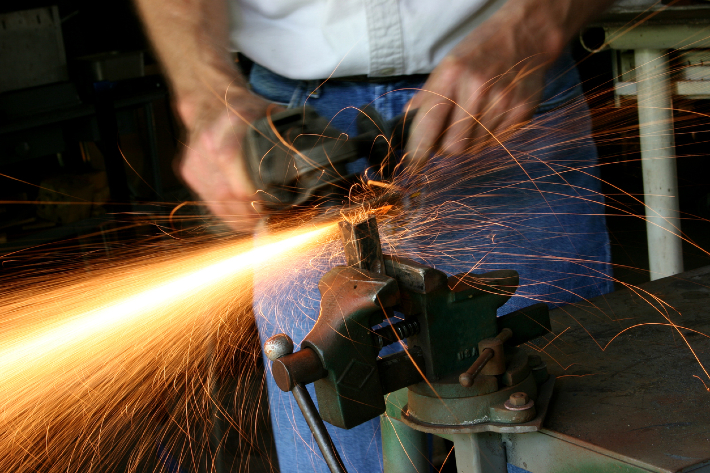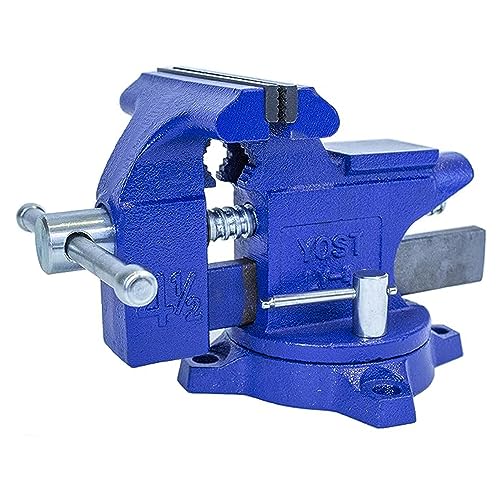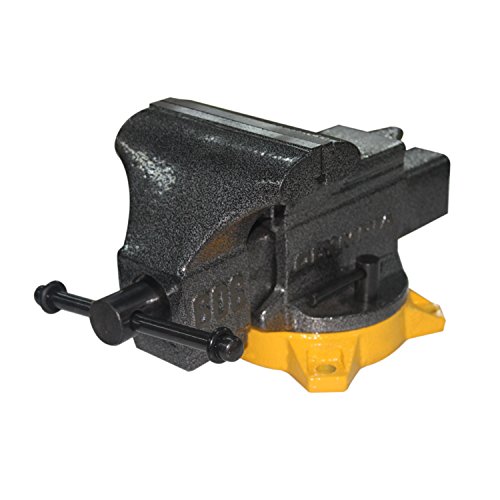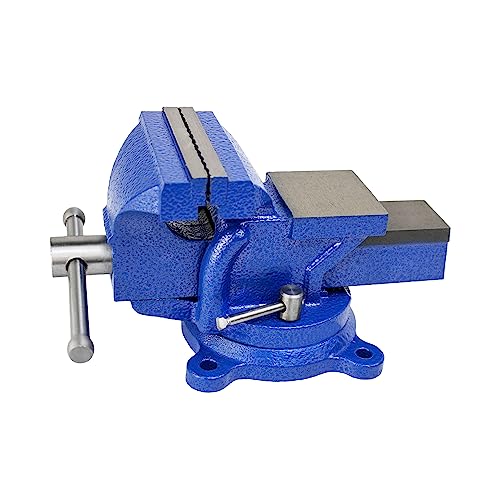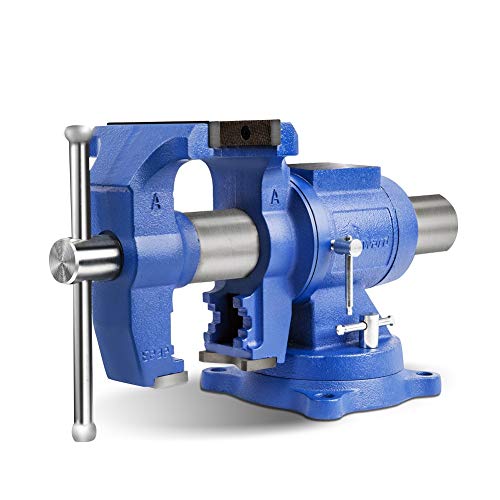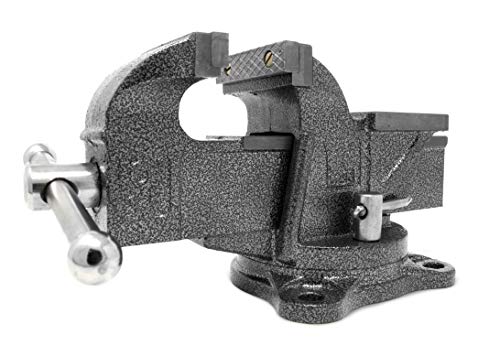- StoreProjects
- Free Plans and Projects
- Furniture Projects
- Jigs And Fixtures Projects
- Shop Projects
- SketchUp Models
- Shop Storage
- Workbenches
- Free Woodworking Downloads From Lee Valley
TechniquesToolsVideos- Premium Streaming Video Site
- Experts Guide to Gluing & Clamping Wood
- Mastering Built-In Furniture
- Simple Live-Edge Slab Table
- CNC – Designed for Woodworkers
- Milling Your Own Lumber
- Advanced Bandsaw Techniques
- I Can Do That! – Simple Woodworking Projects
- Woodwright’s Shop with Roy Underhill
- Tricks of the Trade
BlogOur content is meticulously curated through independent research, testing, reviews, and AI-driven recommendations, all designed to present you with the finest product choices. When you make a purchase through our links, it could result in us earning a commission.The Best Bench Vise for Woodworking, Metalworking, and DIY Projects
Last updated: 19 Jul 2024
A bench vise securely fastens to a base, providing a steadfast grip on pipes and various objects for seamless cutting, reshaping, and crafting endeavors. With an array of sizes available, finding the right fit for your projects is easier than ever. Before making your purchase, consider factors such as the materials you'll be manipulating and specific features that align with your workflow. From permanent bolt attachments to versatile clampers, every detail impacts your vise's performance. Join us as we uncover essential insights and considerations to ensure you secure an ideal bench vise tailored to your needs. Elevate your craftsmanship with confidence and precision as you invest in the ideal tool for your workshop arsenal. Yost Tools stands out among the competition, renowned for crafting the best bench vises that blend durability, precision, and reliability into every design.
- Best Overall: Yost Tools Bench Vise Shop Now ➔
- Most Durable: Olympia Tools Bench Vise Shop Now ➔
- Most Powerful: HFS Bench Vise Shop Now ➔
- Most Flexible: Forward Bench Vise Shop Now ➔
- Most User-Friendly: WEN Bench Vise Shop Now ➔
View all ContentsThe Best Bench Vise
Best Overall
The Yost Tools bench vise is tailored for woodworking and general maintenance tasks. This vise boasts a 240-degree rotating swivel and a robust jaw width of 4 and a half inches, providing unmatched versatility. Constructed from durable cast iron, it delivers impressive pressure up to thirty thousand PSI, ensuring steadfast performance. Accommodating pipes with diameters ranging from 0.5 to 1.85 inches, its jaws offer a secure grip. Complete with a compact yet functional anvil measuring 1 and 3 quarters inches, this bench vise is ready to tackle any project. Conveniently attachable to a 3 x 8 table, this bench vise combines stability and functionality, making it the top choice on our list.
Pros
- Easy to maintain
- Uses standard bolts
- Great for light home use
Cons
- Not suitable for heavy-duty use
Most Durable
This durable bench vise from Olympia Tools is suitable for home use. The package includes a base, polished anvil, swivel, pipe jaws, replaceable hardened steel jaws, and a powerful machine weighing 28 pounds. The machine can be mounted on a 4-lug base, providing you with very sturdy ground to work with. It has a 270-degree swivel, which provides you with ease of usage. Furthermore, it has a 6-inch jaw width and opening, with up to 3 inches of depth, and an anvil that is 2 by 2-quarter inches with a horn for shaping. Lastly, it is made from cast iron, which can create a pressure of 20 thousand PSI.
Pros
- Features a spindle guard for dust protection
- It comes with an anvil horn
- Has replaceable steel jaws
Cons
- Requires both hands to loosen
Most Powerful
The HFS bench vise comes with a large anvil, giving you extra space for those heavy strikes. Unlike other bench vises, this one can have a 360-degree swivel base with double locking for ease of use. Also, this bench vise is operated through a vertical liver, making it easy to use. The bench vise itself clips through powerful steel jaws, which are replaceable and 3.93 inches wide. These jaws can open up to 2.95 inches wide. Lastly, the bench is 14 x 7 x 7 inches, and the weight is only 10 pounds. It is made from alloy steel, which is finished with a blue coating of polished chrome.
Pros
- Made from polished chrome plate
- Easy, one-hand operation
- Compact in size yet powerful to use
Cons
- The mounting hardware is not included
Most Flexible
The Forward bench vise can apply pressure up to 60 thousand PSI, has a jaw width of 5 inches, and a throat depth of 2.6 inches that can easily fit any major hardware inside. A 360-degree rotating lever can tighten up these jaws. The jaws are also replaceable and have a microgroove tooth space for firm gripping. Moreover, the whole hardware can be rotated by a 360-degree rotating swivel, making it easy to rotate the bench vise instead of moving all around the hardware. Also, the bench vise has a big anvil measuring 3.2 to 2.6 inches. The overall bench vise is 18.7 x 10.5 x 10.1 inches in size and is made from ductile iron, which weighs up to 35.1 pounds.
Pros
- Industrial use bench vise
- Comes with easily replaceable jaws
- Easy to use with 360 rotation
Cons
- Prone to rusting
Most User-Friendly
The WEN bench vise is great for all kinds of workpieces at home. It is made from cast iron and has 11 by 12 inches of approximate dimensions and 10 pounds of weight. Furthermore, this bench vise has 3 inches of wide jaws that can open up to 3 and a half inches. The swivel can rotate 130 degrees, providing you with good accessibility to work with. However, this may be compact, but it can apply pressure up to 36 thousand PSI. Plus, it also has a compact anvil of 2.75 x 2.75 inches. Finally, this bench vise is finished with polish and the bottom has 12 mm holes, so you can easily mount it to any table.
Pros
- Easy to set up and use
- Compact and lightweight
- Provides over 1850 pounds of clamping force
Cons
- Not strong enough for industrial use
Buyer’s Guide for Finding the Best Bench Vise
A reliable bench vise is an essential tool for a wide range of projects. In this guide, we’ll explore everything you need to know to make an informed decision, from understanding the different types of bench vises to key features to consider before making your purchase.
Features to Consider When Buying a Bench Vise
Material
Let’s start our guide with the material, as it is the most important thing for hardware. Bench vises are usually made from two types of iron and steel, known as cast iron and forged steel. Let’s talk about cast iron first, as it is the most popular material in the manufacturing of bench vises. It is more affordable than steel, but it is not as strong as the latter, i.e., it can apply pressure ranging from 19 thousand to 60 thousand PSI. It’s made from magnesium, carbon, and silicon, making it less hard and providing greater flexibility. When we include steel in the equation of carbon and silicon, we get a very strong material with less flexibility, which means more vibration when you work with the bench. Forged steel is made from steel subjected to high pressure, yielding an even more excellent-quality product that can apply pressure up to 90 thousand PSI. There is another material called grey iron, made from 95 percent iron. It is vital in quality while also being a good shock absorber.
Durability
It’s better to buy a bench vise of better quality once than spend money over and over again on substandard tools. For more durability, look for a bench vise with replaceable material like the jaws, as the jaws’ teeth after frequent use may require replacement, primarily made from iron.
Weight
If you visit a hardware store and pick two bench vises with the same features but different weights, you will feel that the heavier one is of better quality and material. Weight tells a lot about the hardware’s might. Heavy material will easily take all those strikes you make on the anvil and won’t break. But don’t go for a material that’s too heavy either; it may mostly be a result of lousy manufacturing techniques, especially when you’re choosing a steel bench vise.
Jaw width
Jaw width is the length between the jaws of the bench vise. If you are looking for a bench vise for home use, 3 to 5 inches should be suitable for you. However, for heavy-duty use, you can go for up to 7 inches. Find out the dimensions of the material/sheet you’ll be working with and then go for a suitable bench vise with the required jaw width.
Opening type
There are two ways to open the jaws of your bench vise — manual and quick release. Quick release allows the user to easily open up the tightly locked bolt with just one push. It would seem much now, but quick-release becomes pretty handy, primarily when you work with different sizes of objects.
It saves you a lot of time unscrewing that long bolt attached to the jaws. However, if you will be working with small objects typically of the same size, the manual opening won’t bother you.Types of Jaws
You will be using bench vise for different projects, so it’s best to buy one with versatile uses. For example, you will be working with either pipes or straight objects (nylon and serrated). Usually, bench vises have jaws for both attached; if not, they have replaceable jaws that are either straight or curved depending upon the use. The most common jaw used in bench vises is the serrated jaw, which can usually hold straight objects and pipes. It’s best to choose a bench vise with a combination jaw if you work with straight objects and all kinds of pipes. However, if you are going to be working with PVC pipes and straight objects mostly, then the serrated one of higher quality will come at the same price and will get the job done!
Other Important Things to Consider
Base
Bench vises should be attached to some table or ground via, typically 4 bolts. These bolts are usually not included in an affordable bench vise package, so it’s essential to see if the bench vise you are planning to go for uses regular-size bolts that are easy to acquire from a nearby hardware store. Moreover, lighter bench vises may not even use bolts; they will attach through suction cups or clampings. You will be attaching your bench vise permanently or semi-permanently to a base. So to prevent the hassle of you moving around the hardware, there is a swivel attached to the bottom of most bench vises. These swivels can rotate 120, 180, 270, or even 360 degrees. Angle matters a lot when cutting or reshaping pipes and other hardware, so it’s best to look for bench vises with greater angles for rotation.
Anvil
Anvil seems to be an unimportant feature at first but comes very handy when working at home in a small workshop. It’s a perfect place for heavy hammer strikes for all that material you will use the bench vise to hold. So it’s best to look for this feature while buying a bench vise.
Handle
Long-length items produce greater torque. So it’s best to look for bigger handles when buying heavy-duty bench vises for grand projects. Handles come in the range of 2 to even 7 inches for tightening those jaws on a bench vise.
People Also Ask
Can I grease a bench vise?
Yes, it would help if you did this often. Grease works better than other oils and lubricants.
Can I wield a bench vise?
No, it is not advised to wield a bench vise when it breaks or even to attach it to your table.
Can I prolong the length for extra pressure?
No! Each bench vise has a particular value of maximum pressure; doing so with the pipe may either break the handle or your entire bench vise.
Article Contributors
Read More About Popular Woodworking Reviews Team HereThe Popular Woodworking Review Team’s product reviews and comprehensive guides are here to help you select the best gear and tools to efficiently complete top-quality woodworking projects.
Popular Woodworking is reader-supported: When you buy through links on our site, we may earn an affiliate commission. Artificial Intelligence (large language models) may have been used in the research and creation of the content.
Questions about product testing or a specific articles should be sent to aimperiapt@gmail.com
Related Reviews
Use the Best Plastic Vise Jaws When Working Perfect Your Wood Shaping With the Best Mill Files The Best Band Clamps To Secure Your Workpieces The Best Woodworking Clamps for Fast Setup and Release 5 Best Compact Routers to Easily Shape and Cut Wood The Best Safety Glasses for Clear Vision and Maximum Protection

